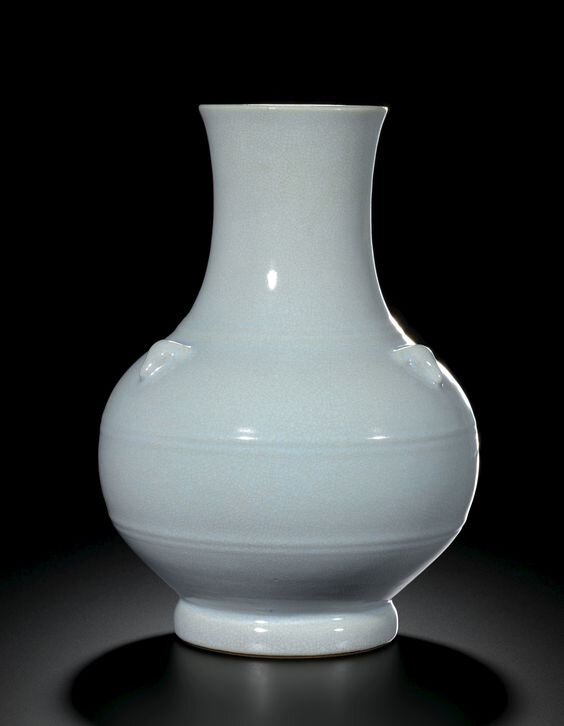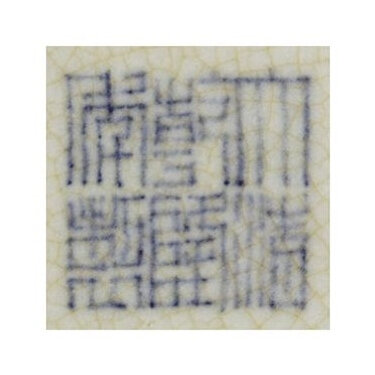A superb Ru-type 'Three Rams' vase, Seal mark and period of Qianlong (1736-1795)


Lot 1934. A superb Ru-type 'Three Rams' vase, Seal mark and period of Qianlong (1736-1795); 34.3 cm., 13 1/2 in. Estimate 7,000,000-9,000,000 HKD (674,841 — 867,652 EUR). Lot Sold: 7,220,000 HKD (696,050 EUR). Photo Sotheby's
finely potted, the globular body supported by a flared foot and rising to a thick waisted neck and flared mouth, encircled by two double-raised fillets around the body and another at the base of the neck, and applied with three ram heads at the shoulders, covered overall with a pale blue glaze suffused with a dense network of golden crackles, the base inscribed with the six-character seal mark in underglaze blue, wood stand.
Note: Vases of this form and design appear to have been introduced in the Yongzheng period; see a line drawing of this form included among Yongzheng shapes in Geng Baochang, Ming Qing ciqi jianding, Hong Kong, 1993, p. 235, fig.401:13, where it is called sanxicun ('vase of three beasts of uniform colour'), referring to the kind of animals used in ritual offerings. While a small group of Qianlong examples are known, the present vase is special for its rich opaque glaze after the famous imperial 'Ru' wares of the Song dynasty. It is closely comparable to a vase sold in these rooms, 8th April 2007, lot 703.
See two further vases, a Yongzheng and a Qianlong example, with a similar Ru-type glaze in the National Palace Museum, Taipei, the former published in the Illustrated Catalogue of Ch'ing Dynasty Porcelain in the National Palace Museum: K'ang-hsi Ware and Yung-cheng Ware, Tokyo, 1980, pl. 129, the latter included in the Museum's exhibition Qingdai danseyou ciqi /Special Exhibition of Ch'ing Dynasty Monochrome Porcelains in the National Palace Museum Taipei, 1989, cat. no. 88. Another Qianlong vase with a Guan-type glaze, in the Walters Art Gallery, Baltimore, is published in S.W. Bushell, Oriental Ceramic Art, London, 1981 (1896), col. pl. LXXVII. For a teadust glazed 'three ram' vase of Qianlong mark and period see one from the collections of T.Y. Chao and Ira and Nancy Koger, sold three times in these rooms, 1979, 1986 and 1992, and once in our New York rooms, 1990, illustrated in Sotheby's. Thirty Years in Hong Kong, Hong Kong, 2003, pl. 157; and a rare celadon-glazed version sold twice in these rooms 8th October 2006, lot 1014, and again, 8th October 2009, lot 1632.
The ram is a traditional emblem of good luck, since the Chinese term for ram (or goat), yang, is a homophone of yang, 'sun' and represents the male or positive principle in the yin-yang duality. The Chinese character for ram is also used as a variant for a similar character pronounced xiang, which means happiness. Three rams, san yang, are considered a particularly auspicious symbol, evoking the expression san yang kai tai, the awakening of nature in spring, which signifies good luck and happiness. San yang shen are the three yang spirits in Daoism, the original spirit, 'the spirit that knows,' and the 'real spirit.'
The Qianlong Emperor appears to have been particularly fond of the motif of the three rams (or goats), since during his reign it was frequently represented in two- and three-dimensional form; see, for example, a jade and a glass carving included in the exhibition China. The Three Emperors, 1662 - 1795, Royal Academy of Arts, London, 2005, cat. nos. 298 and 299. A 'three rams' vase of meiping form with a Guan-type glaze, also of Qianlong mark and period, from the Qing Court collection and still in Beijing, is published in The Complete Collection of Treasures of the Palace Museum: Monochrome Porcelain, Hong Kong, 1999, pl.208.
Sotheby's. Fine Chinese Ceramics & Works of Art. Hong Kong. 05 Oct 2011

/https%3A%2F%2Fprofilepics.canalblog.com%2Fprofilepics%2F1%2F0%2F100183.jpg)
/https%3A%2F%2Fstorage.canalblog.com%2F03%2F02%2F119589%2F96711876_o.jpg)
/https%3A%2F%2Fstorage.canalblog.com%2F11%2F31%2F119589%2F94773502_o.jpg)
/https%3A%2F%2Fstorage.canalblog.com%2F20%2F83%2F119589%2F94772815_o.jpg)
/https%3A%2F%2Fstorage.canalblog.com%2F26%2F72%2F119589%2F75604929_o.jpg)
/https%3A%2F%2Fstorage.canalblog.com%2F59%2F60%2F119589%2F26458628_o.jpg)


/image%2F1371349%2F20240402%2Fob_f03735_865-1.jpg)
/image%2F1371349%2F20240402%2Fob_9318b6_130-1.jpg)
/http%3A%2F%2Fstorage.canalblog.com%2F05%2F67%2F119589%2F128676368_o.jpg)
/http%3A%2F%2Fstorage.canalblog.com%2F57%2F54%2F119589%2F127929957_o.jpg)